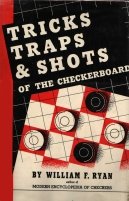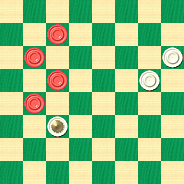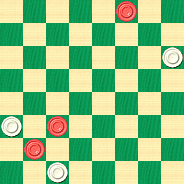The Checker Maven
Jump to navigationTwo Not-Quite-So-Easy Pieces

We've been slowly but surely republishing Willie Ryan's Tricks Traps & Shots of the Checkerboard in a brand new electronic edition, and we've been referring to the introductory problems in the book as "Easy Pieces."
Well, some readers have pointed out that not all of these problems have been exactly easy, and that they've been getting harder as they go. So, this month, we're abandoning any pretense of ease of solution, and again letting Willie speak for himself. Try the problems and check your answers by clicking on Read More. As usual, the Black side is shown in regulation Red.
They may not be easy, but they certainly are good!

BLACK
Black to Play and Win
"A little logic should make the issue clear in Example 13. Black is a piece ahead, but the white king on square 11 is pressing (chasing) an attack from the rear. The natural course for black is to avoid capture by going 16-20, white chasing 11-16, black running 19-23, white pursuing 16-19, and there you have it---black seemingly must lose the piece on 23 or 24. That's the apparent outcome of the situation, but actually black can win in five of his own moves by trapping white on a two-way double or 'optional take.' The one thing to keep foremost in mind, when you are a piece ahead and your opponent is threatening to retrieve it, is to look for an idea that will make the retrieve fatal!"

WHITE
White to Play and Win
"One does not master mathematics by studying trigonometry, solid geometry, or analytics at the start. The would-be mathematician must first ground himself in the basic study of addition, multiplication, subtraction, and division before he can cope with the abstract phases of advanced mathematics. Similarly, one cannot become an adept checker strategist without extensive training in the art of tactics. Look at the three-by-three ending in Example 14, by the well-known American problemist, Paul R. Semple, of Martins Ferry, Ohio. Can you take the white pieces, and without moving a piece, win in ten moves by executing a 'throwback two-for-one'? If you can't, don't divert your study to any other phase of the game until you can see through these snap traps in the twinkling of an eye!"![]()
Solutions
Example 13 16-20, 11-16, 19-23, 16-19, 27-31, 19-28, 20-24!, 28-26, 31-13, and Black wins.
Example 14 21-17, 25-29, 17-13*, 3-7, 12-8, 7-10, 8-3, 10-14, 3-7, 14-18, 7-10, 18-23, 10-14*, 22-26, 14-17*, 26-31, and now the throwout--- 30-25, 29-22, 17-19, ends all; white wins.
You can email the Webmaster with comments on this article.
